新版pep六年级上册英语_各单元知识点总结
新版PEP小学英语六年级上册1-6单元知识点总结
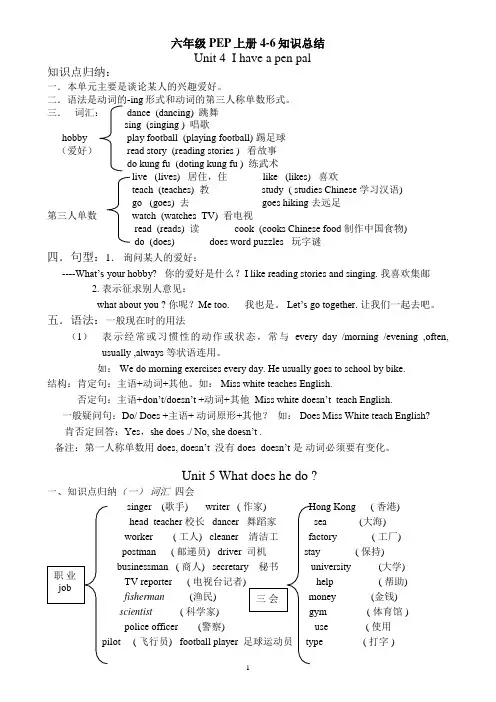
六年级PEP 上册4-6知识总结Unit 4 I have a pen pal知识点归纳:一.本单元主要是谈论某人的兴趣爱好。
二.语法是动词的-ing 形式和动词的第三人称单数形式。
三. 词汇: dance (dancing) 跳舞 sing (singing ) 唱歌hobby play football (playing football) 踢足球(爱好) read story (reading stories ) 看故事do kung fu (doting kung fu ) 练武术live (lives) 居住,住 like (likes) 喜欢 teach (teaches) 教 study ( studies Chinese 学习汉语)go (goes) 去 goes hiking 去远足第三人单数 watch (watches TV) 看电视read (reads) 读 cook (cooks Chinese food 制作中国食物)do (does) does word puzzles 玩字谜四.句型:1. 询问某人的爱好:----What’s your hobby? 你的爱好是什么?I like reading stories and singing. 我喜欢集邮2. 表示征求别人意见:what about you ? 你呢?Me too. 我也是。
Let’s go together. 让我们一起去吧。
五.语法:一般现在时的用法(1) 表示经常或习惯性的动作或状态,常与every day /morning /evening ,often,usually ,always 等状语连用。
如: We do morning exercises every day. He usually goes to school by bike.结构:肯定句:主语+动词+其他。
如: Miss white teaches English.否定句:主语+don ’t/doesn ’t +动词+其他 Miss white doesn ’t teach English.一般疑问句:Do/ Does +主语+ 动词原形+其他? 如: Does Miss White teach English?肯否定回答:Yes ,she does ./ No, she doesn’t .备注:第一人称单数用does, doesn ’t 没有does doesn ’t 是 动词必须要有变化。
新人教版(PEP)小学英语六年级上册各单元知
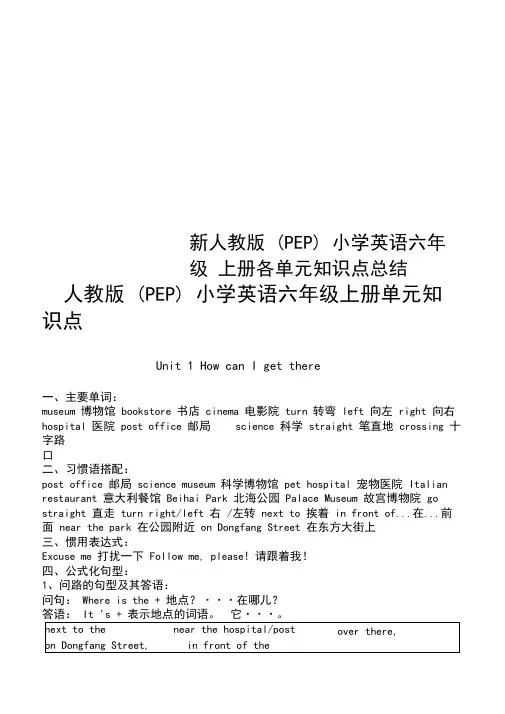
新人教版 (PEP) 小学英语六年级上册各单元知识点总结人教版(PEP) 小学英语六年级上册单元知识点Unit 1 How can I get there一、主要单词:museum 博物馆bookstore 书店cinema 电影院turn 转弯left 向左right 向右hospital 医院post office 邮局science 科学straight 笔直地crossing 十字路口二、习惯语搭配:post office 邮局science museum 科学博物馆pet hospital 宠物医院Italian restaurant 意大利餐馆Beihai Park 北海公园Palace Museum 故宫博物院go straight 直走turn right/left 右/左转next to 挨着in front of...在...前面near the park 在公园附近on Dongfang Street 在东方大街上三、惯用表达式:Excuse me 打扰一下Follow me, please! 请跟着我!四、公式化句型:1、问路的句型及其答语:问句:Where is the + 地点?···在哪儿?答语:It 's + 表示地点的词语。
它···。
2、询问怎么到某地的句型及其答语:问句:How can +主语+ get (to)+地点?···怎么到···?同义句型:Can you tell me the way to + 地点?Where is + 地点?Which is the way to + 地点?答语:Turn +方向+表示地点的介词短语。
···转。
at the cinema at the corner near the post office...五、例句:Where is the cinema, please? 请问电影院在哪里?It ' s next to the hospital. 它与医院相邻。
PEP英语六年级上册各单元知识点归纳及练习
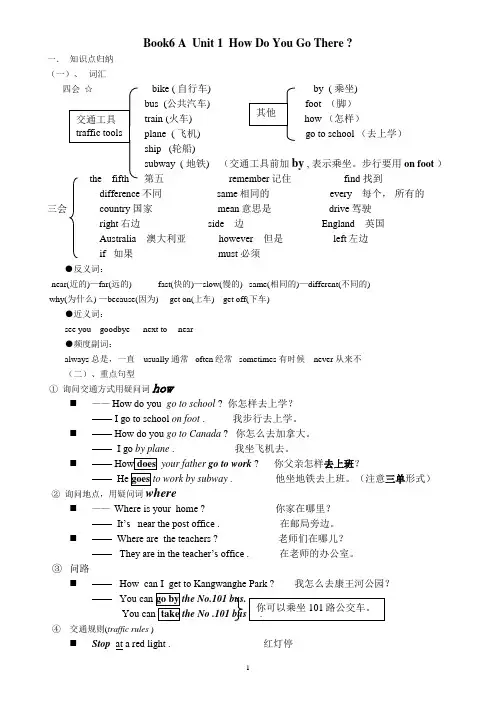
Book6 A Unit 1 How Do You Go There ?一. 知识点归纳(一)、 词汇bike ( 自行车乘坐)公共汽车(脚) 火车(怎样) 飞机(去上学) 轮船)地铁) (交通工具前加by , 表示乘坐。
步行要用on foot )第五 remember 记住 find 找到不同 same 相同的 every 每个, 所有的三会 mean 意思是 drive 驾驶side 边 England 英国澳大利亚 however 但是 left 左边必须●反义词:near(近的)—far(远的) fast(快的)—slow(慢的) same(相同的)—different(不同的)why(为什么) —because(因为) get on(上车)---get off(下车)●近义词:see you---goodbye next to ---near●频度副词:always 总是,一直 usually 通常 often 经常 sometimes 有时候 never 从来不(二)、重点句型① 询问交通方式用疑问词how⏹—— How do you go to school ? 你怎样去上学? —— I go to school on foot . 我步行去上学。
⏹—— How do you go to Canada ? 你怎么去加拿大。
—— I go by plane . 我坐飞机去。
⏹ ——go to work ? 你父亲怎样去上班?—— . 他坐地铁去上班。
(注意三单形式)② 询问地点,用疑问词where⏹—— Where is your home ? 你家在哪里? —— It’s near the post office . 在邮局旁边。
⏹ —— Where are the teachers ? 老师们在哪儿?—— T hey are in the teacher’s office . 在老师的办公室。
pep人教版六年级上册英语各单元知识点
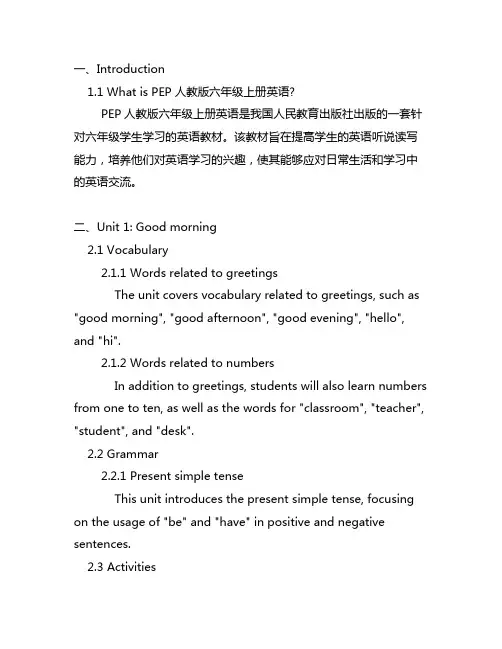
一、Introduction1.1 What is PEP人教版六年级上册英语?PEP人教版六年级上册英语是我国人民教育出版社出版的一套针对六年级学生学习的英语教材。
该教材旨在提高学生的英语听说读写能力,培养他们对英语学习的兴趣,使其能够应对日常生活和学习中的英语交流。
二、Unit 1: Good morning2.1 Vocabulary2.1.1 Words related to greetingsThe unit covers vocabulary related to greetings, such as "good morning", "good afternoon", "good evening", "hello", and "hi".2.1.2 Words related to numbersIn addition to greetings, students will also learn numbers from one to ten, as well as the words for "classroom", "teacher", "student", and "desk".2.2 Grammar2.2.1 Present simple tenseThis unit introduces the present simple tense, focusing on the usage of "be" and "have" in positive and negative sentences.2.3 Activities2.3.1 Role-playingTo practice the new vocabulary and grammar, students can engage in role-playing activities, where they take on the roles of greeting each other and asking basic questions in English.三、Unit 2: I can run3.1 Vocabulary3.1.1 Words related to sports and activitiesIn this unit, students will learn vocabulary related to sports and activities, including "run", "jump", "swim", "dance", "sing", "draw", and "read".3.1.2 Words related to expressing abilityAlong with sports vocabulary, students will also be introduced to words and phrases for expressing ability, such as "can" and "can't".3.2 Grammar3.2.1 Can and can'tThe grammar focus of this unit is on the usage of "can" and "can't" to express one's ability or inability to do something.四、Unit 3: At the zoo4.1 Vocabulary4.1.1 Words related to animalsThis unit covers vocabulary related to animals, such as "elephant", "panda", "tiger", "lion", "zebra", "giraffe", and "kangaroo".4.1.2 Words related to colorsStudents will also learn words for different colors, as many animals' physical characteristics are associated with specific colors.4.2 Grammar4.2.1 There is and there areThe grammar point of this unit is on the usage of "there is" and "there are" to talk about the existence of animals and objects at the zoo.4.3 Activities4.3.1 Describing animalsTo practice the new vocabulary and grammar, students can engage in activities where they describe different animals at the zoo using the words and phrases they have learned.五、Unit 4: Our classroom5.1 Vocabulary5.1.1 Words related to classroom objectsThis unit introduces vocabulary related to classroomobjects, such as "blackboard", "book", "pen", "pencil", "ruler", "desk", and "chair".5.1.2 Words related to prepositionsAlong with classroom objects, students will also learn prepositions such as "on", "in", "under", "behind", and "next to".5.2 Grammar5.2.1 Prepositions of placeThe grammar focus of this unit is on the usage of prepositions of place to describe the location of objects within the classroom.5.3 Activities5.3.1 Classroom scavenger huntTo reinforce the new vocabulary and grammar, students can participate in a classroom scavenger hunt, where they use prepositions to describe the location of different objects in the classroom.六、Unit 5: My school day6.1 Vocabulary6.1.1 Words related to school subjectsThis unit covers vocabulary related to school subjects, such as "Chinese", "math", "English", "music", "PE", "art", and puter".6.1.2 Words related to timeAlong with school subjects, students will also learn words and phrases related to time, such as "morning", "break", "lunch", "afternoon", and "evening".6.2 Grammar6.2.1 Present continuous tenseThe grammar focus of this unit is on the usage of the present continuous tense to talk about activities happening at the present moment.6.3 Activities6.3.1 Creating a daily scheduleTo practice the new vocabulary and grammar, students can create a daily schedule, using school subjects and time-related words to describe their typical school day.七、ConclusionThe PEP人教版六年级上册英语教材 covers a wide range of vocabulary, grammar, and activities that aim to provide students with a solid foundation in English language learning. By introducing topics such as greetings, sports, animals, classroom objects, and school subjects, the textbook offers students opportunities to engage in meaningful language use and develop essential language skills. With its systematicandprehensive approach to language learning, PEP人教版六年级上册英语 helps students cultivate their interest in English and facilitates their language acquisition process.。
新版PEP小学英语六年级上册1-6单元知识点总结
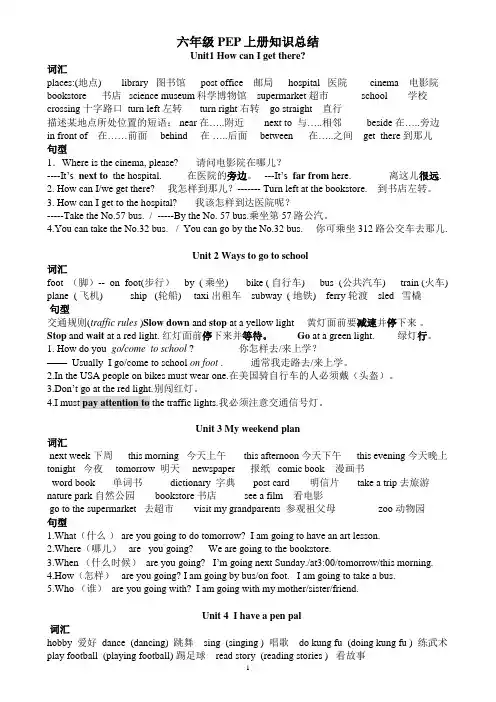
六年级PEP上册知识总结Unit1 How can I get there?词汇places:(地点) library 图书馆 post office 邮局 hospital 医院 cinema 电影院bookstore 书店 science museum科学博物馆 supermarket 超市 school 学校crossing 十字路口 turn left 左转 turn right 右转 go straight 直行描述某地点所处位置的短语: near 在…..附近 next to 与…..相邻 beside 在…..旁边in front of 在……前面 behind 在…..后面 between 在…..之间 get there 到那儿句型1.Where is the cinema, please? 请问电影院在哪儿?----It’s next to the hospital. 在医院的旁边。
---It’s far from here. 离这儿很远.2. How can I/we get there? 我怎样到那儿?------- Turn left at the bookstore. 到书店左转。
3. How can I get to the hospital? 我该怎样到达医院呢?-----Take the No.57 bus. / -----By the No. 57 bus.乘坐第57路公汽。
4.You can take the No.32 bus. / You can go by the No.32 bus. 你可乘坐312路公交车去那儿.Unit 2 Ways to go to school词汇foot (脚)-- on foot(步行) by ( 乘坐) bike ( 自行车) bus (公共汽车) train (火车) plane ( 飞机) ship (轮船) taxi 出租车 subway ( 地铁) ferry 轮渡 sled 雪橇句型交通规则(traffic rules )Slow down and stop at a yellow light 黄灯面前要减速并停下来。
新版PEP小学英语六年级上册1-6单元知识点总结
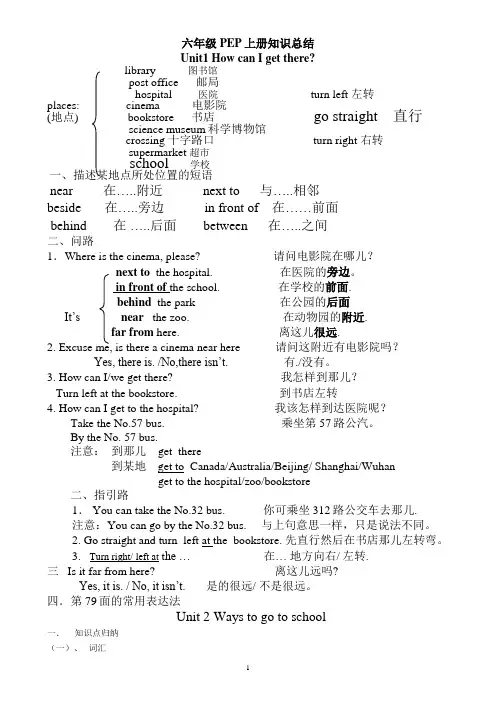
六年级PEP上册知识总结Unit1 How can I get there?library 图书馆post office 邮局hospital 医院turn left 左转places: cinema 电影院(地点) bookstore 书店go straight 直行science museum科学博物馆crossing 十字路口 turn right 右转supermarket 超市school 学校一、描述某地点所处位置的短语near 在…..附近 next to 与…..相邻beside 在…..旁边 in front of 在……前面behind 在…..后面 between 在…..之间二、问路1.Where is the cinema, please? 请问电影院在哪儿?next to the hospital. 在医院的旁边。
in front of the school. 在学校的前面.behind the park 在公园的后面It’s near the zoo. 在动物园的附近.far from here. 离这儿很远.2. Excuse me, is there a cinema near here 请问这附近有电影院吗?Yes, there is. /No,there isn’t. 有./没有。
3. How can I/we get there? 我怎样到那儿?Turn left at the bookstore. 到书店左转4. How can I get to the hospital? 我该怎样到达医院呢?Take the No.57 bus. 乘坐第57路公汽。
By the No. 57 bus.注意:到那儿 get there到某地 get to Canada/Australia/Beijing/ Shanghai/Wuhanget to the hospital/zoo/bookstore二、指引路1. You can take the No.32 bus. 你可乘坐312路公交车去那儿.注意:You can go by the No.32 bus. 与上句意思一样,只是说法不同。
PEP人教版小学六年级英语上册知识点
六年级上册知识点Unit 1 How do you go to school?主要单词:by plane 坐飞机by ship 坐轮船on foot步行by bike 骑自行车by bus 坐公共汽车by train 坐火车traffic lights交通灯traffic rules交通规则Stop at a red light 红灯停Wait at a yellow light 黄灯等Go at a green light 绿灯行主要句子:How do you go to school?你怎么去上学?Usually I go to school on foot. Sometimes I go by bus.通常我步行去上学。
有时候骑自行车去。
How can I get to ?我怎么到达中山公园?You can go by the No. 15 bus.你可以坐15路公共汽车去。
知识点:1、There are many ways to go somewhere.到一个地方去有许多方法。
这里的ways一定要用复数。
因为there are是There be句型的复数形式。
2、get to到达.关本单元我们还要学习与get相关的短语:get on 上车get off下车3、on foot 步行乘坐其他交通工具大都可以用介词by…, 但是步行只能用介词on 。
4、go to school的前面绝对不能加the,这里是固定搭配。
5、USA 和US 都是美国的意思。
另外America也是美国的意思。
6 go to the park前面一定要加the.如果要去的地方有具体的名字,就不能再加the , 如果要去的地方没有具体名字,由要在前面加the. go to school除外。
7、How do you go to …?你怎样到达某个地方?如果要问的是第三人称单数,则要用:How does he/she…go to …?8、反义词:get on(上车)---get off(下车) near(近的)—far(远的) fast(快的)—slow(慢的) because(因为)—why(为什么)same(相同的)—different(不同的)9、近义词:see you---goodbye sure---certainly---of course0、频度副词:always 总是,一直usually 通常often经常sometimes 有时候never 从来不Unit 2 Where is the science museum?主要单词:library 图书馆post office 邮局hospital医院cinema 电影院bookstore书店science museum科学博物馆turn left向左转turn right 向右转go straight 直行north北south南east东west西主要句子:Where is the cinema, please? 请问电影院在哪里?It’s next to the hospital. 它与医院相邻。
人教版PEP 英语六年级上册 全册各单元知识点总结
Unit 1 How can I get there?一、地点词汇library 图书馆post office 邮局hospital 医院turn left 左转turn right 右转cinema 电影院bookstore 书店go straight 直行science museum科学博物馆crossing 十字路口supermarket 超市school 学校二、描述某地点所处位置的短语near 在…..附近next to 与…..相邻beside 在…..旁边in front of 在……前面behind 在…..后面between 在…..之间三、问路1.Where is the cinema, please? 请问电影院在哪儿?next to the hospital. 在医院的旁边。
in front of the school.在学校的前面.It’s behind the park .near the zoo. 在动物园的附近.far from here. 离这儿很远.2. Excuse me, is there a cinema near here.请问这附近有电影院吗?Yes, there is. /No,there isn’t.有./没有。
3. How can I/we get there? 我怎样到那儿?Turn left at the bookstore. 到书店左转4. How can I get to the hospital? 我该怎样到达医院呢?Take the No.57 bus. 乘坐第57路公汽。
By the No. 57 bus.注意:到那儿get there到某地get to Canada/Australia/Beijing/ Shanghai/Wuhanget to the hospital/zoo/bookstore四、指引路1.You can take the No.32 bus.你可乘坐312路公交车去那儿.注意:You can go by the No.32 bus.与上句意思一样,只是说法不同。
PEP初中英语六年级上册知识点归纳
PEP初中英语六年级上册知识点归纳一、语法篇1. Be动词:是,am,are,was,were,been。
2. 疑问词:what,where,when,why,how,who。
3. 情态动词:can,could,may,might,should,must。
4. 祈使句:动词原形。
5. 一般现在时:主语+V(原形)+其他。
6. 现在进行时:主语+be+V(ing)+其他。
7. 一般过去时:主语+V(过去式)+其他。
8. 过去进行时:主语+was/were+V(ing)+其他。
9. 将来时:主语+will/shall+V(原形)+其他。
10. 过去将来时:主语+would/should+V(原形)+其他。
二、词汇篇1. 人称代词:I,you,he,she,it,we,they。
2. 物主代词:my,your,his,her,its,our,their。
3. 形容词:big,small,long,short,tall,fat,thin,heavy,light,old,young。
4. 副词:often,seldom,always,never,sometimes,very,too,so,quite。
5. 数词:序数词(first,second,third)和基数词(one,two,three)。
6. 时间词:week,month,year,morning,afternoon,evening,night。
7. 颜色词:red,green,blue,yellow,white,black。
8. 动词:play,listen,watch,read,write,swim,dance,sing,draw,speak。
9. 名词:book,desk,chair,table,bed,door,window,picture,pen,ruler,bottle,bag,pencil case。
三、对话篇3. Talking about family: How many people are there in your family? What do your parents do?4. Talking about hobbies: Do you like…? What’s your favourite…?5. Talking about school: What subjects do you study at school? Who’s your favourite teacher?6. Talking about daily routines: What time do you get up/go to bed? What do you do on weekends?希望以上知识点归纳对您有所帮助。
人教版PEP 英语六年级上册 全册各单元知识点总结
人教版PEP 英语六年级上册全册各单元知识点总结Unit 1 How can I get there?一、地点词汇在问路时,掌握一些地点词汇是必要的,这些词汇包括library(图书馆)、post office(邮局)、XXX)、cinema(电影院)、bookstore(书店)、supermarket(超市)、school (学校)等等。
二、描述某地点所处位置的短语在描述某地点所处位置时,可以使用一些短语,如near (在…。
附近)、next to(与…。
相邻)、XXX(在…。
旁边)、in front of(在……前面)、behind(在…。
后面)、een(在…。
之间)等等。
三、问路当我们不知道某个地方在哪儿时,可以问路。
问路时,我们可以使用一些常用的句型,如“Where is the cinema。
please?”(请问电影院在哪儿?)、“Excuse me。
is there a cinema near here?”(请问这附近有电影院吗?)、“How can I get there?”(我怎样到那儿?)等等。
四、指引路当我们知道了某个地方的位置后,我们需要指引路。
指引路时,我们可以使用一些常用的短语,如“You can take the No.32 bus.”(你可乘坐312路公交车去那儿)、“Go straight and turn left at the bookstore.”(先直行然后在书店那儿左转弯)、“Turn right/ left at the …”(在…地方向右/左转)等等。
Unit 2: Ways to Go to SchoolDo you live far from school。
You may need to choose a XXX method to get there。
Here are some common n tools you can use: bike。
- 1、下载文档前请自行甄别文档内容的完整性,平台不提供额外的编辑、内容补充、找答案等附加服务。
- 2、"仅部分预览"的文档,不可在线预览部分如存在完整性等问题,可反馈申请退款(可完整预览的文档不适用该条件!)。
- 3、如文档侵犯您的权益,请联系客服反馈,我们会尽快为您处理(人工客服工作时间:9:00-18:30)。
Unit 1 How can I get there?一:重点单词和短语Science科学, museum博物馆, post office, bookstore, cinema, hospital ,tasty, buy, London Eye伦敦银, stomach胃 ,crossing十字路口, turn left, turn right,go straight=walk straight直走.next to紧挨着/与。
相邻, far from(离。
远),near在。
附近 ,behind(在。
后面) , in front of(在。
前面) , between…and…(在。
和。
之间)二:按要求写单词:hot(反义词)cold , cool(反义词)warm, too(同音词)to/two can not(缩写)can’t right(反义词)left/wrong buy(同音词)by/bye sea(同音词)see first(基数词)one four(序数词)fourth did (原形)do /does three(序数词)third give(过去式)gave三:重点句型分析1.Where is the museum shop?此问句是由特殊疑问词where 引导的一个特殊疑问句, where意为“在哪里,到哪里”,用来询问地点,放在句子的开头。
询问“某人或某物在哪里”的基本句型是:“ Where +is/are+ 主语?”, where is 后接名词或代词的单数形式,where are 后接名词或代词的复数形式。
表示地点的词:museum博物馆, post office邮局, bookstore书店, cinema电影院, hospital医院 restaurant餐馆bank银行 bus stop公交车站lake湖 library图书馆zoo动物园 school学校 park公园 garden花园 hotel旅馆2.It’s near the door.此句中near是表示位置的介词,意为“旁边,附近”,其同义句是:It’s nextto the door.它在门的旁边。
表示位置的短语:next to the bookstore挨着书店 near the hospital在医院附近 near the post office在邮局附近over there 在那边on Dongfang Street在东方大街上 in front of the school在学校前面3. How can we get there?此句用来询问“怎样去某地”,后面直接跟地点。
回答时,可以用“Turn left, turn right, go straight.”等句来回答。
同义句:1.Can you tell me the way to+地点?2.Where is the +地点?3.Which is the way to +地点4. Turn left at the bookstore. Then turn right at the hospital. 此句是指路的句型。
常用到的句型有:turn left, 向左转turn right, 向右转go straight直着走。
同时表示在某处的介词用at.5.Is the Thames far from here? No, it isn’t.此句是个be动词开头的一般疑问句,其回答要用Yes或No. 句中的far from 意为“离……远”。
反义词组为next to.Unit 2 Ways to go to school一:重点单词和短语on foot步行, by bus =take a bus 乘公交车 by plane,乘飞机 by taxi 乘出租车by ship乘船 by subway 乘地铁by train乘火车 by bike骑自行车by ferry乘轮渡Hooray!好极了slow down 慢下来, stop 停 wait等 pay attention to注意 cross the road 横穿马路 traffic light通信号灯at home在家 missed(miss的过去式)想念 different,不同chopsticks,筷子(复数)cross穿过 look right向右看 same 相同的door门look at朝。
看 play with和。
一起玩二:按要求写单词:go (反义词)come foot(复数)feet child(复数)childrenearly(反义词)late good(反义词)bad坏 take带走(反义词)bring拿来slow(反义词)quick/fast go (过去式)went do(过去式) diddo(第三人称单数) does go(第三人称单数) goessame 相同的(反义词)different不同的 miss(过去式) missedwrong 错误(反义词)right正确 can(否定形式)can’t三:重点句型分析1.How do you come to school?你(们)怎么来学校的?此问句是由特殊疑问词how引导的特殊疑问句,用于询问对方的出行方式。
回答时要根据具体情况作答。
表示地点的词:Germany德国 Munich慕尼黑 England英国 Australia澳大利亚school学校 the park 公园the cinema电影院 the hospital医院 the post office邮局the bus stop公共汽车站 home家ually, I come on foot.=Usually, I walk.通常情况下,我步行来。
此句是对出行方式的回答句。
其中usually意为“通常”,表示频率很大, on foot意为“步行”。
一般用by表示出行方式。
By后面一定要直接加交通工具的单数形式,只有“小脚丫”foot与on 搭配,“步行”用on foot表示。
3. I must pay attention to the traffic lights.我必须注意交通信号灯。
Must是情态动词,意为“必须”后面跟动词原形。
动作词组:wear a helmet戴头盔 pay attention to the traffic lights注意交通信号灯look right向右看4. Don’t go at the red light!别闯红灯!此句是Don’t开头的否定祈使句, don’t后面跟动词原形。
意为“不要做某事”。
动作词组:run跑 go at the red light闯红灯 touch the door触摸门Eg. Don’t smoke.不要吸烟。
/禁止吸烟。
Don’t take photos.禁止拍照。
5 We must look right before crossing the road.我们在横穿马路前必须看看右边。
此句中must是情态动词,意为“必须”后面跟动词原形,在此句中before是一个介词,而介词后面跟动词-ing形式。
6. There is no door on the bus.公共汽车上没有门。
此句是there be句型的单数句, be动词要根据后面名词的单复数形式来决定,名词为单数或不可数名词就用there is, 名词为复数就用there are. 此句中no door意为“没有门”,表示单数含义,因此要用there is开头。
Unit 3 My weekend plan一:知识点小结重点单词和短语visit拜访 film电影 see a film看电影 trip旅游take a trip去旅游supermarket, 超市evening晚上,傍晚 tonight在今晚tomorrow明天next week下周dictionary 字典comic 滑稽的comic book连环画册word book单词本postcard明信片learn 学习teach教disturb打扰 without没有pool池子 jump in跳进 remember记住 lesson 课space太空 travel(尤指长途)旅游 half一半 price 价格moon 月亮 make a snowman 堆雪人share sth(事)with sb(人)和某人分享某物 lots of= a lot of 许多二:按要求写单词look for (同义词) find leaf (复数) leaves picture (复数) picturessee (同义词) watch/look film (同义词) movie buy (反义词) sell am /is /are (原形) be is /am (复数)are this (反义词) that going (原形) go swim (现在进行时)swimming can(否定形式) can’t too(同音词) two /to clothe(复数)clothes ice-skate(现在进行时)ice-skatingautumn(同义词) fall autumn(反义词)spring teach (反义词) learn三:重点句型分析1.---What are you going to do tomorrow?---I’m going to have an art lesson. 此句是个一般将来时态的特殊疑问句。
用了be going to 结构。
“be going to +动词原形”构成一般将来时态,表示计划、安排将要做的事或根据目前推测将要发生的动作,意为“打算,将要”。
表示时间的单词:evening晚上,傍晚 tonight在今晚tomorrow明天next week 下周this morning今天早晨 this afternoon今天下午 this evening 今天晚上this weekend 下周末动词短语原形:make a snowman 堆雪人 take a trip去旅游 see a film看电影 visit my grandparents 拜访祖父母watch TV看电视learn how to swim 学怎样游泳go skating去滑冰row a boat划船go fishing 去钓鱼 go skiing去滑雪 go shopping去购物 make mooncakes 做月饼 read a poem读诗eg: I’m going to make a snowman.我打算去堆雪人。
We’re going fishing.我们打算去钓鱼。
